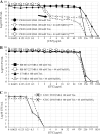Scope and Predictive Genetic/Phenotypic Signatures of Bicarbonate (NaHCO3) Responsiveness and β-Lactam Sensitization in Methicillin-Resistant Staphylococcus aureus
- PMID: 32041719
- PMCID: PMC7179597
- DOI: 10.1128/AAC.02445-19
Scope and Predictive Genetic/Phenotypic Signatures of Bicarbonate (NaHCO3) Responsiveness and β-Lactam Sensitization in Methicillin-Resistant Staphylococcus aureus
Abstract
Addition of sodium bicarbonate (NaHCO3) to standard antimicrobial susceptibility testing medium reveals certain methicillin-resistant Staphylococcus aureus (MRSA) strains to be highly susceptible to β-lactams. We investigated the prevalence of this phenotype (NaHCO3 responsiveness) to two β-lactams among 58 clinical MRSA bloodstream isolates. Of note, ∼75% and ∼36% of isolates displayed the NaHCO3 responsiveness phenotype to cefazolin (CFZ) and oxacillin (OXA), respectively. Neither intrinsic β-lactam MICs in standard Mueller-Hinton broth (MHB) nor population analysis profiles were predictive of this phenotype. Several genotypic markers (clonal complex 8 [CC8]; agr I and spa t008) were associated with NaHCO3 responsiveness for OXA.
Keywords: antimicrobial susceptibility testing; beta-lactams; methicillin-resistant Staphylococcus aureus; sodium bicarbonate.
Copyright © 2020 Ersoy et al.
Figures




References
-
- Fowler VG Jr, Sakoulas G, McIntyre LM, Meka VG, Arbeit RD, Cabell CH, Stryjewski ME, Eliopoulos GM, Reller LB, Corey GR, Jones T, Lucindo N, Yeaman MR, Bayer AS. 2004. Persistent bacteremia due to methicillin-resistant Staphylococcus aureus infection is associated with agr dysfunction and low-level in vitro resistance to thrombin-induced platelet microbicidal protein. J Infect Dis 190:1140–1149. doi: 10.1086/423145. - DOI - PubMed

